Table of Contents
The Biggest Challenges Global Marketing Leaders Expect to Face in 2025
- Adopting a data-driven marketing strategy.
- Integrating AI into marketing workflows.
- Mastering the transition to short-form video content.
- Bridging the personalization gap in customer experiences.
- Overcoming challenges with content marketing.
- Aligning the right influencers with your audience.
- Optimizing content through strategic pruning for better SEO.
- Finding the balance between creativity and data.
- Pivoting during unexpected shifts in consumer behavior.
- Adapting to data privacy regulations.
- Aligning product positioning across teams.
- Synchronizing campaigns across multiple channels.
1. Adopting a data-driven marketing strategy.
Why It's a Challenge
Marketers are leaning more toward behavioral data, like content consumption and shopping habits, but it’s tough to balance that with traditional demographic info.
With 33.43% focusing on content habits and 31.77% on demographics, it’s clear that understanding not just who your audience is but how they act is getting more complicated.
What can you do?
To stay ahead, marketers have to mix both behavioral and demographic insights into their strategy. Understand how your audience consumes content and shops.
Microsoft's Global Head of Programmatic Evangelist, Daniel Godoy, told me that it‘s critical marketers keep first-party data in mind if they’re aiming to expand their reach in 2025.
“Marketers feel the pressure to win the ads race in a wild WWW. During this race, it's worth mentioning that consumer media behavior is changing, and advertising strategies, too,” he said. “With the cookies deprecation coming (although it has been delayed by Google), it should be on our radar that at least 40% of browsers today don't get signals.”
Godoy adds, “Shaping your strategy by leveraging 1P or 3P trustable data becomes necessary to expand potential reach and start piloting your data strategy for the future.”
First-party data can ultimately help you ensure you're reaching the right audiences with your ads and turning those audiences into high-quality leads.
Once you‘ve defined your audiences and properly segmented them, you’ll need to develop unique messaging that resonates with your prospects.
2. Integrating AI into marketing workflows.
Why It's a Challenge
AI is a life-saver, but a lot of marketers are still figuring out how to make the most of it.
Even though 52.76% of respondents in our survey say they understand how to use AI and 53.73% can measure its impact, similar percentages indicate a significant gap in both understanding and applying AI effectively.
Furthermore, SurveyMonkey found that 69% of marketing pros are pumped about AI and how it’s changing their jobs, while 17% feel a mix of excitement and worry.
On top of that, 60% are feeling really good about where the industry is headed, and just 1% are super pessimistic. Overall, the feeling is optimistic.
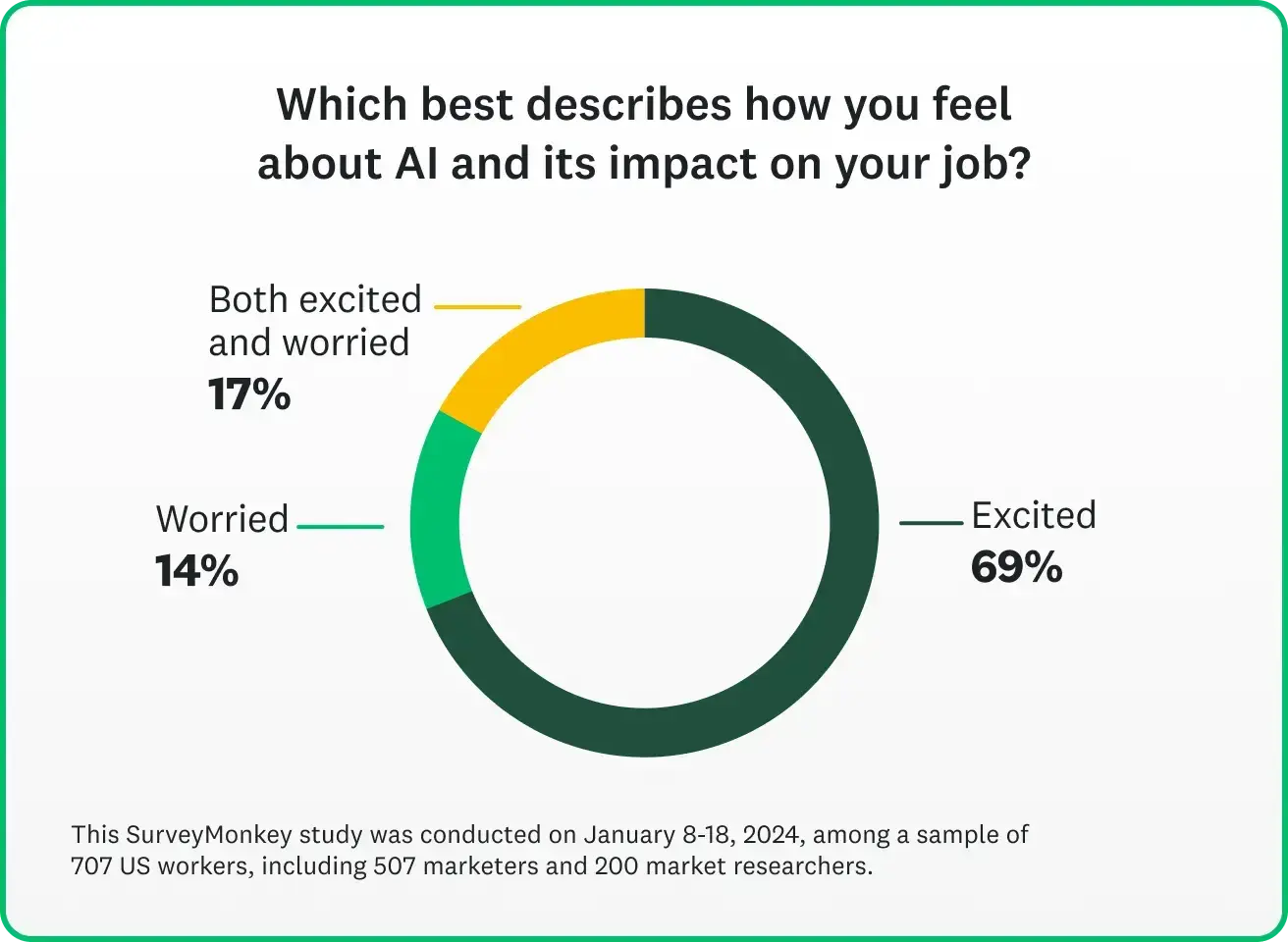
What can you do?
To close the knowledge gap, marketers need to sharpen both their technical know-how and their ability to track and measure results.
40% of businesses have already made a proactive move by bringing in specialized AI experts to improve their marketing efforts.
Focus on learning how to implement AI and analyze its impact.
3. Mastering the transition to short-form video content.
Why It's a Challenge
Video is stealing the spotlight in marketing, especially short-form content on platforms like TikTok, YouTube, and Instagram. LinkedIn no longer falls behind, too.
The real challenge for marketers is keeping up with the shift toward social video, where younger audiences are turning to engage with brands more than on search engines. So you’ve got to be quick and smart about creating content that captures attention.
What can you do?
Ramp up your focus on short-form video — it’s expected to see the most growth in 2025.
Use social listening and sentiment analyzing tools to figure out the questions your audience is asking, and have your content team develop content that resonates.
Even better, tap into your brand advocates to help share the answers, expanding your reach and credibility.
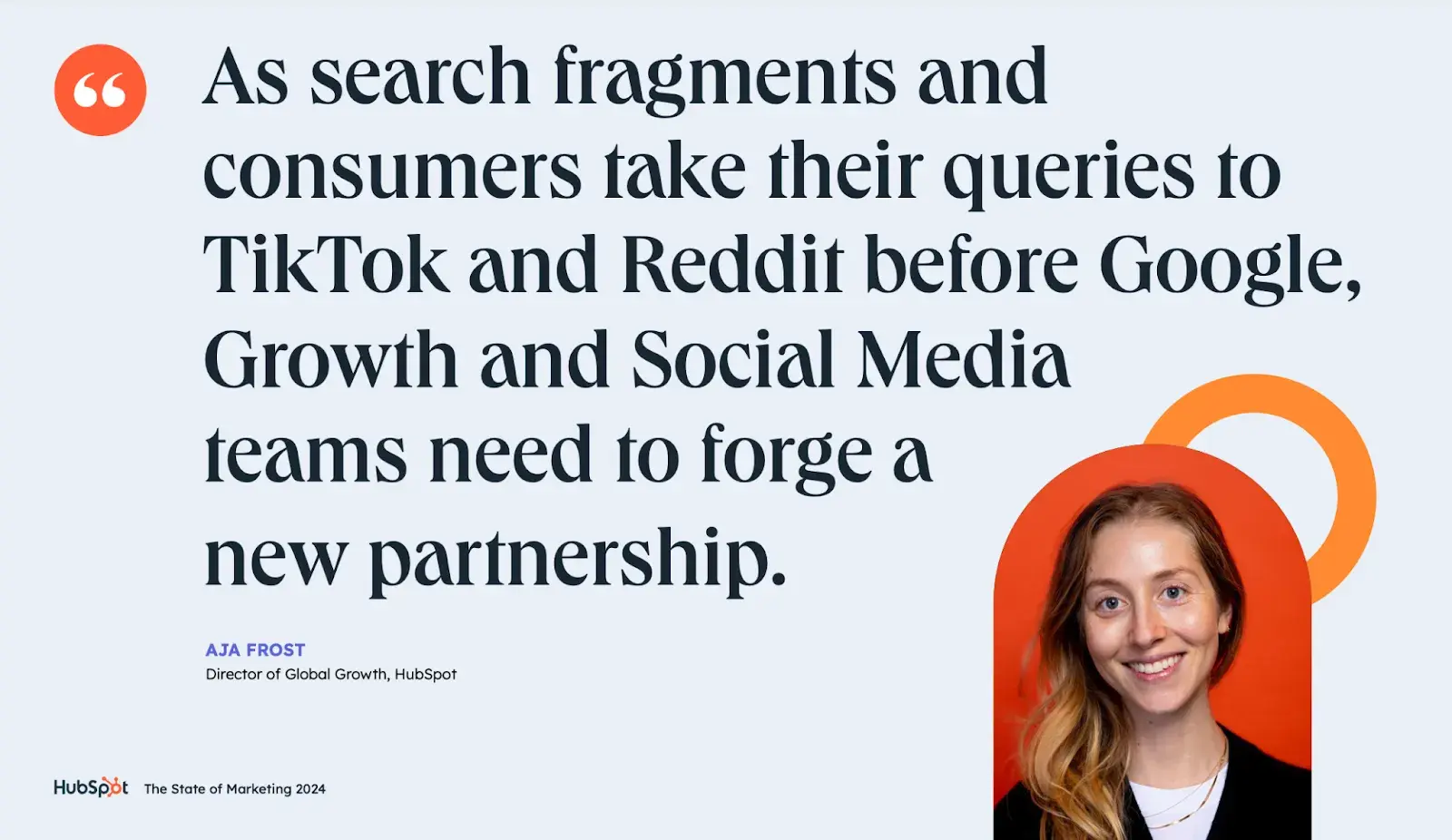
4. Bridging the personalization gap in customer experiences.
Why It's a Challenge
56.35% of marketers agree that marketing has changed more in the past three years than in the last fifty. That’s huge.
The biggest shift? The demand for personalized content. While 65% of consumers say brand content feels relatable, only 35% of marketers believe their customers are actually experiencing true personalization.

Even though 65% of marketers claim to have high-quality audience data, it’s clear many aren’t using it effectively to build stronger, more meaningful connections with their audiences.
What can you do?
To close this gap, double down on using your data more effectively:
- Improve audience segmentation by dividing users into micro-segments.
- Scale up personalization — craft ad messages that speak to micro-segments’ desires and fears.
- A/B test and refine creatives.
5. Overcoming challenges with content marketing.
Why It's a Challenge
Finding fresh ideas for new content tops the list of struggles, with 16% of marketers agreeing on it. In turn, 16% of marketers define it challenging to create content that drives high levels of online engagement — like clicks, shares, and comments.
For 15% of marketers, developing content that attracts more traffic to their website is a major challenge.
What can you do?
Tip #1: Lean into E-E-A-T
To receive more clicks, “Your content strategy must start with what users need, not what’s most efficient for you. If you look at recent Google updates, you’ll notice that Google has been refining what “helpful content” means and prioritizing the “E” for “experience” in E-E-A-T.
Your content must be personal, demonstrate experience, and address real needs. And you’re already playing catch-up.” — Ben Steele, Senior Editor at Search Engine Journal
Tip #2: Create better headlines.
To drive initial traffic from the web, work on your headline sharpness. A Danish news outlet, TV 2 Fyn, conducted A/B tests to improve CTR using ChatGPT to generate headlines. Over three weeks, they ran 46 A/B tests. AI-generated headlines won 46% of the tests, while human-created headlines won 24%.

A great read: Is AI-Generated Content Good for SEO?: 300+ Web Strategists Weigh In
Tip #3: Social listening.
To idiate, lean into social listening (aka study thematic subreddits, X, Threads, LinkedIn comments, etc). You can also automate this work with AI tools.
Plus, put your audience’s needs first — a single topic can be covered in multiple ways with unique angles for each.
Test new content formats with video embeds, infographics, or interactive quizzes.
6. Aligning the right influencers with your audience.
Why It's a Challenge
Influencer marketing can backfire if the influencer doesn’t align with your audience’s needs. Maris Laatre, CMO of Bully Max, recounts a campaign:
"While we got good engagement, the sales didn’t match up … we realized that the influencers weren’t speaking directly to our core audience."
The right message paired with the right audience is crucial for conversions.
What can you do?
Maris emphasizes the importance of focusing on influencers whose audience matches your target market, rather than just the size of their following.
Also, the influencer’s message should be authentic and resonate with their followers otherwise it’ll just be a waste of money and energy.
And remember, micro-influencers will often bring you way more benefits than the big ones.
7. Optimizing content through strategic pruning for better SEO.
Why is it a challenge?
Deciding to prune or merge a significant portion of your content is a high-stakes decision for any marketing team. It’s not just about cutting low-performing pages — it’s about taking a calculated risk. Marketers must weigh the loss of existing traffic (even if small) against the potential for long-term growth.
Emilia Korczynska shared a great post on this topic. Userpilot removed 23% of their blog content, equivalent to $261,443 in production costs, and pages that drove over 24,000 visitors in 2024 alone. Yet, this led to a 16% increase in visitor’s count.
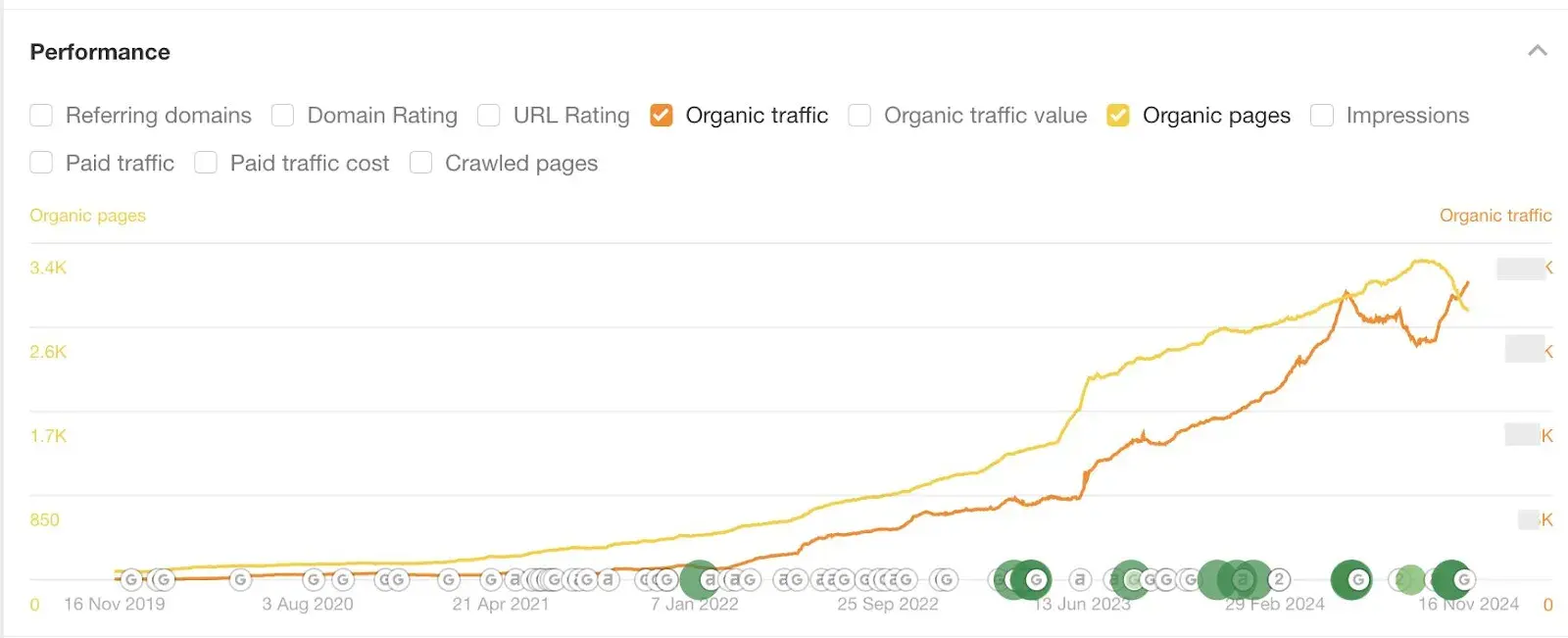
What can you do?
Take a data-driven approach to decide what content to prune. Emilia’s method highlights key steps:
- Focus on underperforming content — posts with low conversions, minimal traffic, or outdated relevance.
- Consolidate duplicate or redundant posts to reduce cannibalization and improve search intent alignment.
- Remove content optimized for keywords with zero or low search volume.
- Evaluate backlinks and prioritize pages that add measurable value.
8. Finding the balance between creativity and data.
Why It's a Challenge
The tension between creativity and data is a challenge many marketers face. Roland Jakob from BlazeKin.Media explains: “Early on, I leaned heavily into analytics, thinking numbers alone would lead the way. But I realized that creativity often speaks a language data can’t quantify — at least not immediately.”
What can you do?
Combine data with storytelling. “During my time at Pagnolia, our campaign with a polished message didn’t resonate with the audience until we pivoted to a more raw, story-driven approach. This shift turned the campaign into one of our most engaging, resulting in a 30% boost within six months” continues Roland.
He also suggests using so-called “customer co-creation.” By bringing customers into the process — not just as buyers, but as collaborators — brands can build stronger loyalty and create campaigns that resonate more deeply.
9. Pivoting during unexpected shifts in consumer behavior.
Why It's a Challenge
17.54% of marketers say keeping up with rapidly changing customer behaviors is one of their biggest challenges.
Consumer behavior can change overnight, and the pandemic was a perfect example. Maris from Bully Max recalls: “When the pandemic hit, we saw an unexpected rise in pet adoption… we had to pivot quickly and scale up our messaging.”
What can you do?
Stay agile during such shifts to seize new opportunities and scrutinize behavioral analytics.
10. Adapting to data privacy regulations.
Why It's a Challenge
Data privacy regulations are constantly evolving as well, making it challenging for marketers to stay compliant.
The best example is a recent situation that happened in one Belgian company. A former employee asked for her photo to be removed from the company website six months after leaving.
The photo included her name, position, and a group shot. Under GDPR Article 17, people have the right to have their personal data, including photos, deleted when there’s no valid reason for keeping them or if consent is withdrawn.
The employer didn’t comply, so the data protection authority stepped in and ordered the photo to be removed right away.
What can you do?
Stay informed on new regulations unfolding and be extra cautious with campaigns. Huge articles will be buzzed about on social media, so your job is to get the gist and act on it.
Fines are high for violating these rules, so it's important to stay vigilant.
11. Aligning product positioning across teams.
Why It's a Challenge
I bet this point gives you shivers. Cus who hasn’t suffered from sales and marketing teams clashing over lead quality, lead nurturing, you name it?
Our research also highlights that companies with aligned sales and marketing teams are 103% more likely to beat their goals than companies that aren’t aligned.
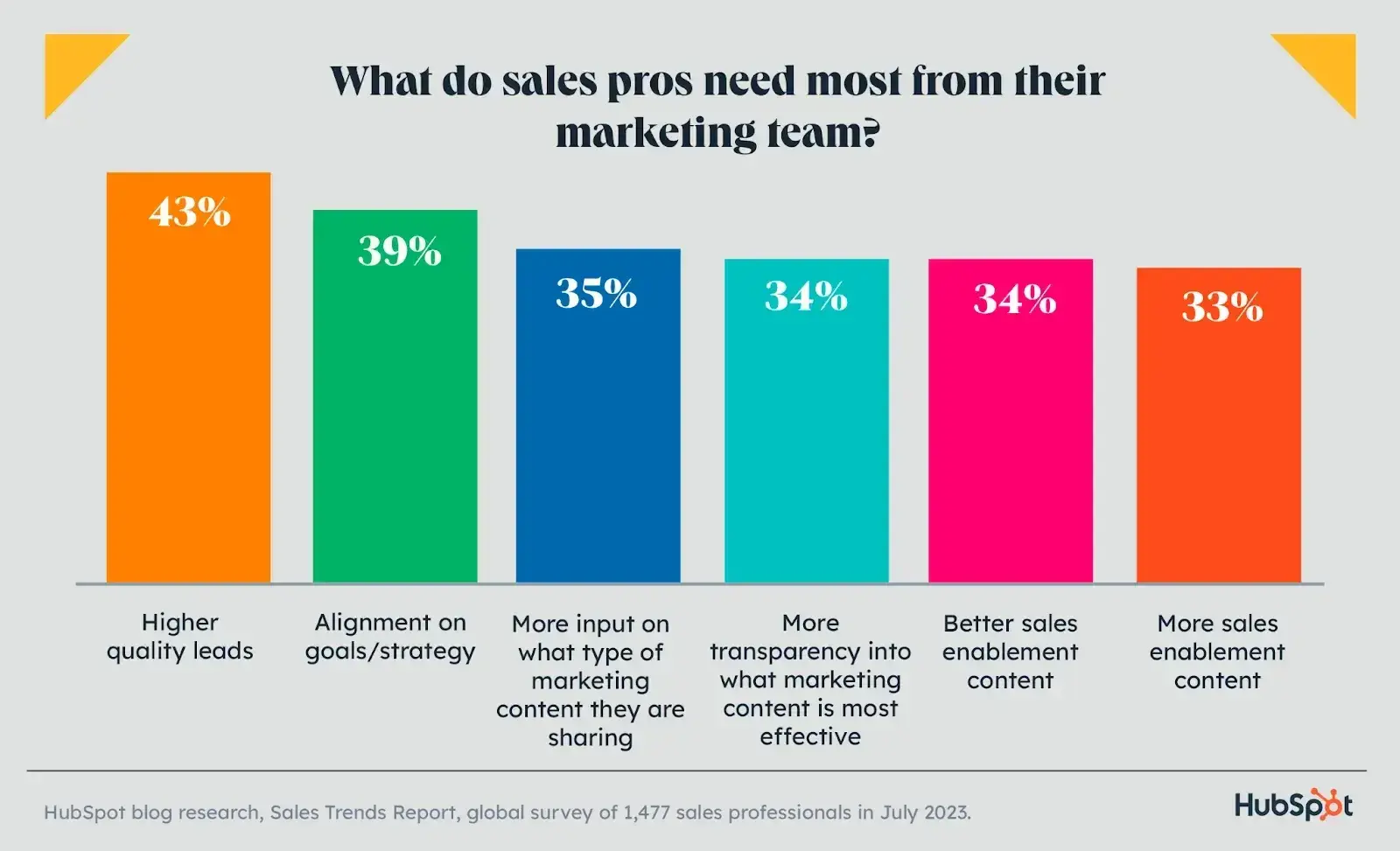
But wait, there’s more. Product teams can also have their own perspective, adding insult to injury.
Altogether leads to discrepancies in messaging and creates confusion both internally and externally.
What can you do?
A simple cure is to have all teams on the same page by sharing insights, campaign performance and sales results and refining the message together.
12. Synchronizing campaigns across multiple channels.
Why It's a Challenge
A major setback in marketing campaigns often happens when other marketing channels don’t align with the primary campaign objectives, which happened to Kognic.
“Our website campaign designed to drive conversions didn’t succeed because we hadn’t built concurrent messaging with enough scale on our earned and paid channels at the same time,” shares Steven Spieczny, VP of Marketing at Kognic.
In short, this lack of synchronization meant missed opportunities to create a seamless experience across all touchpoints.
What can you do?
Whether it’s paid ads, social media, or email campaigns, each channel should deliver the same message with unified goals.
Second, coordinate the timing and messaging across all touchpoints to build a stronger, more consistent customer experience.
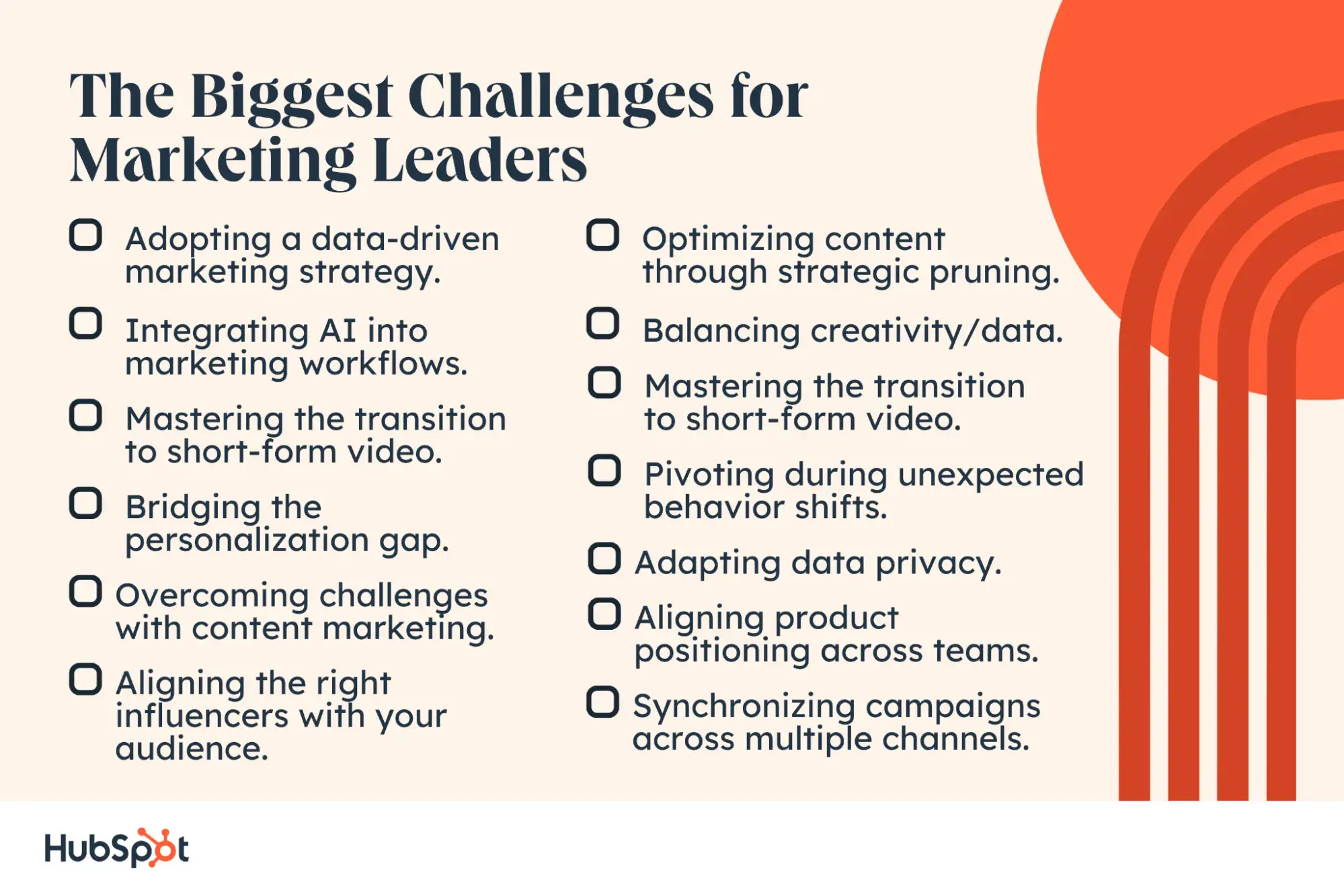
Top U.S. Marketing Executive Challenges
While global and U.S.-based participants from both of our recent studies anticipate a similar list of challenges, the way they’re prioritizing them shifts when sampling just U.S.-based executives.
Strategic blockers like making data-driven decisions, keeping up with trends, and content pivots are top-of-mind for marketers.
Meanwhile, U.S. leaders polled in our Executive Marketing survey are focused on the bottom line. They’re preparing for financial challenges like generating revenue, securing budget, and sales-marketing alignment.
This isn’t shocking. While many countries are in a time of financial uncertainty following the pandemic, the U.S. has faced lots of contradicting news reports about whether we are or aren’t in a recession.
With this in mind, marketing leaders are focused on saving resources, ensuring they get the money they need, and justifying their work, headcount, or investments by showing revenue attribution or business-wide impact.
Luckily, whether you're dealing with any of the global or U.S.-based challenges, many of them can be navigated with the insights and takeaways above, such as:
- Collecting the best analytics possible to make data-backed decisions, ideally by merging first-party data and GDPR-approved third-party data.
- Knowing how your buyer is continuing to evolve. You can also use data and sales-marketing alignment to stay in touch with what your customers and audiences are focusing on.
- Ensuring that you approach marketing strategies or investments strategically by asking yourself, “What is the ROI, business impact, or revenue opportunity here?”
- Preparing to pivot. The only constant thing in marketing is change and many of us have already started working backup or pivot-planning into our strategies for when trends or circumstances around us change suddenly.
- Building a great employer brand. By doing so, you'll attract all sorts of marketing talent who can navigate many of the challenges above.
Get Inside the Minds of Today's Marketing Leaders
As a marketer and partnership manager myself, I can tell you that there’s no shortage of challenges. But, we’re hired to solve the riddles.
Interested in other top challenges, trends, and opportunities that marketing leaders are focusing on, or want to learn how to build tactics that will get you visibility by solving their pain points? Check our our latest report on executive leadership priorities.
Editor's note: This post was originally published in October 2022 and has been updated for comprehensiveness.
Marketing Strategy


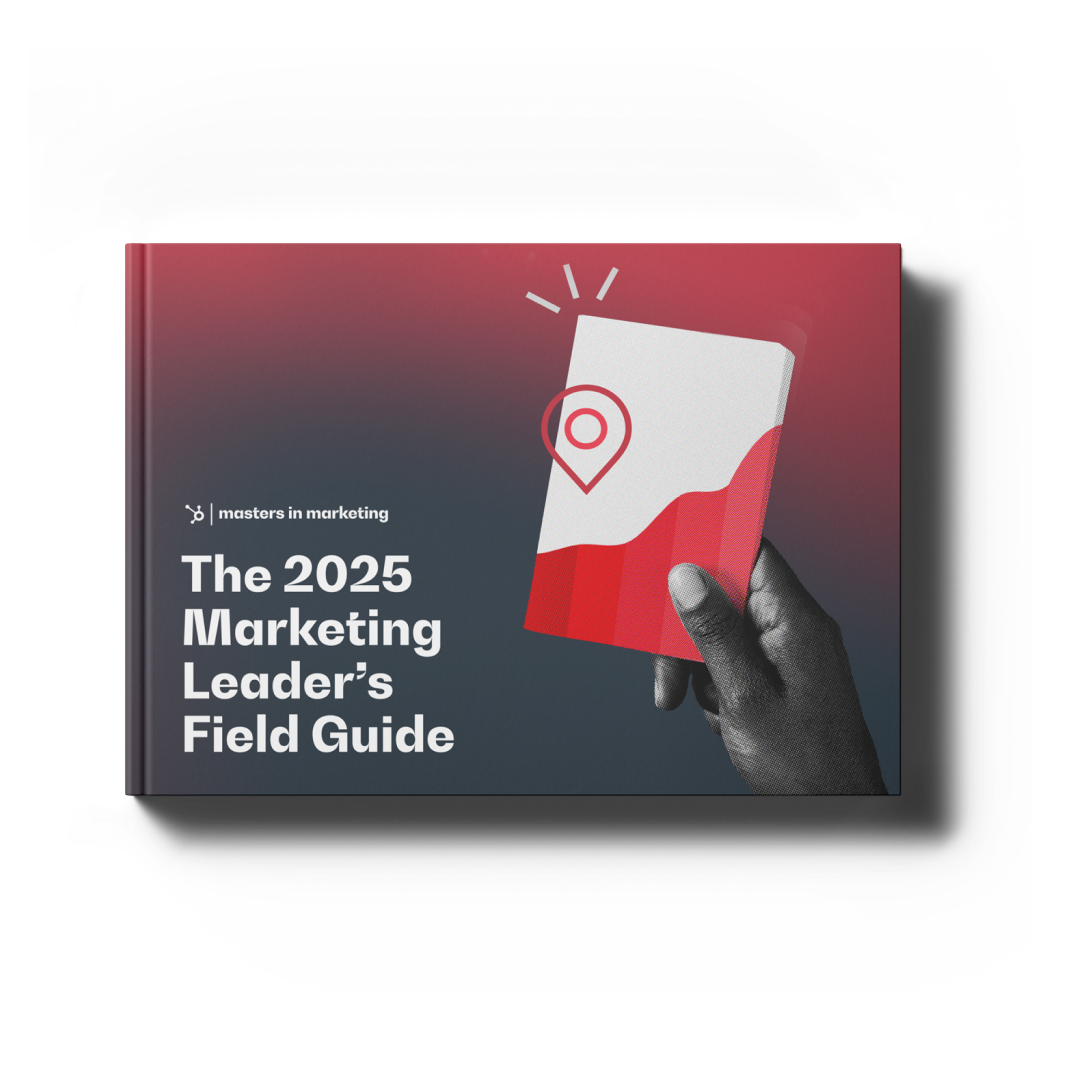




![The state of inclusive marketing in 2025 [new data + expert insight]](https://53.fs1.hubspotusercontent-na1.net/hubfs/53/inclusive-marketing-report.webp)
![How marketers are navigating a possible recession (and advice about what you should do during it) [new data]](https://53.fs1.hubspotusercontent-na1.net/hubfs/53/image12-May-27-2025-02-18-19-8390-AM.png)



![Cultural Marketing: What It Is & How to Do It The Right Way [According to Experts]](https://53.fs1.hubspotusercontent-na1.net/hubfs/53/Untitled%20design%20-%202025-04-03T163531.949.jpg)